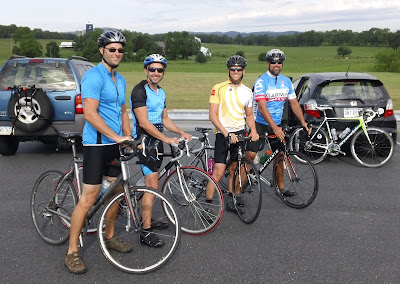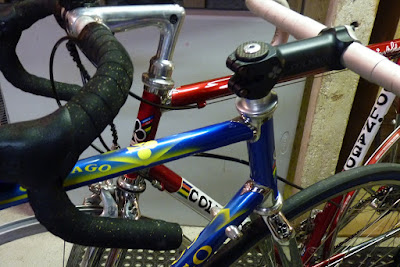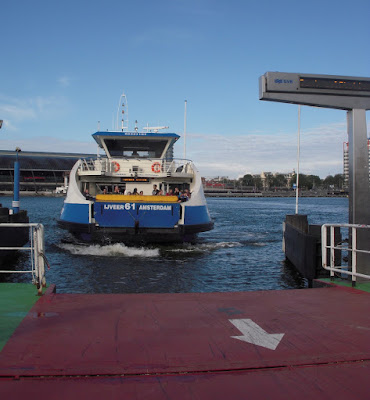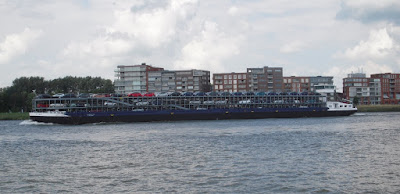(8th and final trip log)
We took our time packing up from our
Rotterdam apartment and caught the tram back the kilometer or so to the station. Two
and a half weeks into this adventure, we were both “three euros interested” in
not having to haul our bags any more than we had to!
After
less than an hour train ride into the immense Amsterdam train shed, we still
had a little time to kill before checking into the houseboat property on which
we were staying across the IJ (pronounced “eye) River. Sue left me in a quiet
spot with our luggage and went to find the food store, which was supposed to be
close by.
When she returned, I glanced across the
hallway in which we were sitting and noticed a teenaged boy wearing a “Hill
Soccer” t-shirt. The colors matched up with those of the Hill School in
Pottstown, about a 20-minute drive from our home. I quickly walked across to
ask, “That’s not the Hill School, is it?”
The boy and his father both gave me a
stunned look. “It sure is!” they answered, almost in unison. I told them where
we lived, and received a “You’ve got to be kidding,” since John, his son Johnny and family
live just a couple miles away from us in Limerick Township. In fact, they knew a few of
the guys I ride with regularly, as the children attended Upper Providence
Elementary, where my friends teach.
John explained that they had been using
Amsterdam as a home base and were heading out to Bruges. After telling them how
much we enjoyed the city, they said they were heading home on Wednesday, and I told
them we were, too. Of course, the next question was, “What city are you flying
to?” You could probably guess by the way this is going, that we ended up on the
same flight!
 |
| The massive train shed, as viewed from the northside of the IJ |
Exiting the station to the ferry, Sue and I were
stunned by the thousands of bicycles stored in the area. There was even a barge
docked directly in front of the station – just for daily on-deck bicycle
parking!
I want
to mention how impressed I was by the transportation around Holland
(provincially-speaking), with street-level trams and buses, subways and trains
running everywhere, on time with convenient connections. Rotterdam also had integrated
the impressive highspeed waterbuses into their system, and Amsterdam’s FREE
ferry stopped at several locations up and down the waterfront!
Sure, there are automobiles, but unlike the
U.S., they are de-emphasized as the primary means of transportation. Bicycles
are the way to move, and it really is ridiculous to think of the small trips we
Americans make every day in our (often WAY-oversized) cars.
People can argue about the independence achieved
with an automobile, and certainly a car is useful when moving between rural
locations, but wasting the premium space of an inner city with parking lots
just isn’t logical. Now, I realize there are some cities without convenient
waterways and others where subway construction isn’t feasible, but light-rail
trains and trams are possible anywhere. And it is amazing to experience the
flow of people when every street has bike lanes and pedestrian-only avenues are
a common feature!
Getting onto the ferry was difficult for
newbies like us, as we just weren’t used to negotiating the flow of
pedestrians, cyclists and (motor)scooter riders – especially with the luggage! We
became even more alert to being run over when exiting the ferry, as folks were
opening up the speed, instead of when they were slowing onto the deck.
Near the north-side ferry slip were the cool
Eye Filmmuseum building and the A’DAM Lookout, which includes swings that hangs
out over the edge of the 20-story rooftop (second photo below). I wasn’t interested in that for any number of euros! We had a pleasant walk
along the canal and across a lock to reach our accommodations.
Since we had full cooking and cold storage facilities here, we took a walk out to the Jumbo market. I was familiar with the store
only because it is a co-sponsor (with Lotto-NL) of a pro cycling team, but it
turned out to be like an undersized Wegman’s with one of the best selections of
gluten-free products I have ever seen...PAAARTY! They also had these large
blocks of chocolate, with the unexpected name of “Tony’s Chocolonely”, to which
we had become addicted – sea salted caramel in milk chocolate for Sue, dark with
sea salted almonds for me.

Later we hopped on the short ferry across
the river, then took another longer trip down river to Buiksloterham, a former
port area that is being re-developed. Right at the ferry slip is the Amsterdam
Botel, now docked semi-permanently at this site - the letters are actually
rooms! Much of the area is being cleared, but a few properties have been
converted to residential use. Some are interesting (a huge grain warehouse, and
a crane), and some are kind of
sketchy (stackable ship containers).
I have to say, at this point Sue and I were
finding Amsterdam to be a bit disappointing. It certainly had more old world
charm than Rotterdam, but the streets here were overrun by tourists and the
surroundings were drab, and at times really filthy. We also noticed that the
people, despite the city's wild reputation, seemed really gruff and often
downright rude. Sue commented how she found the Parisians to be so much more
friendly - so that's saying something!
I don’t want to be overly critical of the
city, because I had one particularly fantastic day full of Rembrandt (personal
favorite) and Van Gogh. I also had an unexpectedly enjoyable European naval
history lesson at the Rijksmuseum. I'll leave you to look up the Battle of
Medway, if you are even remotely interested, but I was fascinated by the
display, which included an immense oil painting detailing the battle, the
complete stern facade from the captured British flagship Royal Charles and
the incredibly detailed replica of a Dutch warship, which was about the height/length of a Sunfish sailboat. I was amazed to think that the actual warship was
twelve times the size of the model, and I amused myself to think of the damage
this little vessel could inflict out on the Schuylkill’s Boathouse Row!
We found the city to be much more attractive
from canal level during our boat tour the next afternoon. Maybe it was
because the guides were taking us to the more scenic parts of town, or perhaps
it was because, from that low vantage point, we couldn’t see as much of the
kitschy storefronts or dirty streets.
Many of the bridges under which we passed
had little cut-outs with a cleat that could be used to tie open-top boats onto and
keep passengers out of the rain. At one point our guides took advantage of one
of these temporary shelters, since they were keeping watch on the radar for a
passing shower, but nothing but a few drops came down.
 |
| Amsterdam has its share of unstable foundations and leaning buildings! |
 |
| A famous view of the "Seven Bridges", all of similar construction |
Using a bicycle route map that was left at
our room, I had planned a loop ride out to the rural areas north of the city, part of which would
traverse the dikes lining the Markermeer. This was once part of the Zuiderzee,
a saltwater inlet from the North Sea that was dammed in 1932 to form the
freshwater IJsselmeer (not a typo, they leave the capital “IJ”, to denote the outlet
of the namesake river). In 1976, this body of water was split in two again by a
dam project, forming the Markermeer on the southern end.
Sue was interested in riding west to Haarlem,
and I really didn’t want to do the (planned) total 40+ miles on one of the
utility-type bikes, so we stopped at a few rental places to see if they had any
wielrenfietsen (sport bikes)
available. The super-friendly staff at "A-bike Shop" hooked me up with an excellent
Sensa Umbria – not a brand I was familiar with, but even with its lower-level
Shimano Claris components, it turned out to function well and was one of the
quietest bikes I’ve ever ridden!
They were also reserving for Sue an
excellent hybrid bike made by Gazelle, the largest and most famous manufacturer
of Dutch bicycles.They used to produce high-end racing machines, but have
moved away from them because of market demand in the country – and based on how
difficult it was to find a decent road bike, I can understand their decision!
We started off riding from our side of the
river out to Buiksloterham and took the ferry across to the western docks of Amsterdam.
From there it was just under ten miles, weaving through a couple of parks,
while following the general route of the Haarlemmerweg canal.
The skies were overcast most of the day, but
the rain held off. Unfortunately there was a 15-20 mph wind hitting us right in
the face the whole ride west. I was at an advantage with the more aerodynamic
riding position, while Sue was really fighting the wind on her upright bike. She
couldn’t really tuck in behind me to draft effectively either.
Sue was pretty much toast when we arrived in
Haarlem, which had more of the small-town look and feel we enjoyed in Bruges.
We sat down on a bench along the River Spaarne and enjoyed a makeshift picnic,
while Sue contemplated taking the train back to Amsterdam. She was interested
in maybe doing a little riding around the city and thought the ride back would
ruin any chance of doing that, so we rode to the station to see how much it
would be.
 |
| Along the Spaarne in Haarlem |
I put a little effort into trying to talk her out
of it, since the wind at our backs would be much more fun on the return
journey, but I think she knew how much I was looking forward to really letting
the pedals fly. When Sue looked at the ticket screen at the terminal and said, “Oh
yeah, I’m ten euros interested in the train,” I knew I was on my own.
She had a little bit of a wait for the next
arrival, and there were a couple intermediate stops, but I was still a bit
shocked when I arrived back at our room before her. That wasn’t exactly some
rinky-dink local shuttle covering that 10 miles, so I must have been moving! I
did a quick rearrangement of some of the kit I take with me for emergencies,
grabbed a digital camera, plus my little sheet with directions and off I went
on the next section of my ride.
I was a little misdirected at one point and
ended up a mile or so down the wrong road, and then a local gentleman sent me
the wrong way. I ended up at a small bus shelter that had a great map, and a
young woman who lived nearby helped to show me exactly where I needed to go.


From there on, I was going pretty much where
I had planned, crossing through beautiful open farmland and over neat little
bridges at the intersecting canals. My original intention was to cross the larger
waterway on my right at a small ferry in the town of Holysloot, but when I
arrived at the trail that was supposed to take me there, it was nothing but a
series of rickety plank bridges and a flattened grass track leading off towards
the town. I didn’t really want to risk this rental bike on that terrain, and
the signpost detailing the privately-run ferry left me questioning whether the
operator was even going to be there by the time I reached it. I decided to do a
five-mile detour out around to a bridge
crossing to the north, which I had already checked out in my pre-planning
session, just in case!
At this point the weather started to turn a
bit sour, as the winds kicked up even more and a misty rain started to fall –
not a soaking downpour, just enough to make it unpleasant. I didn’t really
notice how the village ahead and the tree line were blocking my view of the
horizon, but as I emerged from the cluster of houses and followed the bike path
up a small incline... WHAM - I was right on top of the dike looking out over
the Markermeer, quite a dramatic entrance! I snapped some photos, panning left to right:
I followed the path about a mile south until
I was flanked by water on both sides.
HERE is a nice
YouTube video that someone shot of the area. This person had nicer weather and
a whole lot more company up on the bike path, but I found it funny that you can
also hear the howling wind in his video!
Soon I was riding on a herringbone brick
road into the pretty village of Durgerdam. Established in 1421, the community
once thrived with fishermen, but the damming of the Zuiderzee brought that to a
halt. There is still a bustling marina nearby and the area is a very popular
cycling destination.
I hadn’t really planned out the return to
our accommodations too precisely from there, since it was pretty much just
following the IJ River back to the canal. However, I was forced to take a
couple of detours, first due to a ridiculous bridge repair (I think with a good
amount of speed, and the construction debris out of the way, I might have been
able to jump the stream!) and then a rural
section of the trail that was closed “for improvements”. I planned just over
forty miles, but ended up doing closer to sixty for the day and, except for a
bit of frustration at being misdirected, loved every minute of it!
Yes, I was a bit tired of living out of a
suitcase for three weeks (Sue for FIVE!), but I was disappointed to leave,
particularly with the web of bike routes out there to explore. Sue was heading
back on a separate flight as part of the package deal she bought when flying
to Paris, so I wouldn’t have company returning to the States. However, I did
have John and his family to help pass the (LONG) time waiting in the customs
line in Newark – and they definitely know where to turn if they have any bike
repairs or purchases to make!

























































